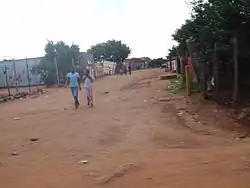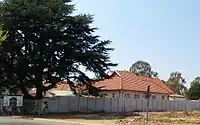East Rand
The East Rand is the urban eastern part of the Witwatersrand that is functionally merged with the Johannesburg conurbation in South Africa. This area became settled by Europeans after a gold-bearing reef was discovered in 1886 and sparked the gold rush that gave rise to the establishment of Johannesburg.
East Rand | |
|---|---|
      | |
| Country | South Africa |
| Province | Gauteng |
| Municipality | Ekurhuleni |
| Government | |
| • Mayor | Mzwandile Masina |
| Area | |
| • Total | 1,975 km2 (763 sq mi) |
| Population | |
| • Total | 3,178,470 |
| • Density | 1,600/km2 (4,200/sq mi) |
| Racial makeup () | |
| • Black African | 78.7% |
| • Coloured | 2.7% |
| • Indian/Asian | 2.1% |
| • White | 15.8% |
| First languages () | |
| • Zulu | 28.8% |
| • English | 12.0% |
| • Afrikaans | 11.9% |
| • Northern Sotho | 11.4% |
| • Other | 35.9% |
| Time zone | UTC+2 (SAST) |
| PO box | 1462 |
The large black townships of the East Rand were the scene of heavy clashes between the African National Congress and the Inkatha Freedom Party before the end of Apartheid.
The region extends from Germiston in the west to Springs in the east, and south down to Nigel, and includes the towns of Boksburg, Benoni, Brakpan, Kempton Park, Edenvale, and Bedfordview.
As part of the restructuring of municipalities in South Africa at the time, the local governments of the East Rand were merged into a single municipality in 1999, called City of Ekurhuleni Metropolitan Municipality, meaning "place of peace".
Despite having a separate municipal government, like the West Rand, the East Rand is included as the part of the Witwatersrand urban area. To this end, the East Rand shares the same dialling code as Johannesburg (011 locally) and the same metropolitan route numbering system as Johannesburg (and the West Rand). It is not uncommon for residents of the East Rand to work in Johannesburg proper and vice versa.
